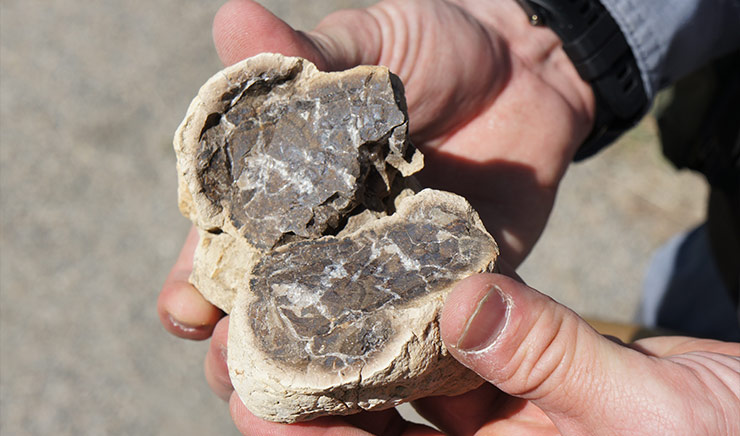Colorado Fossils Show How Mammals Rebounded After the Dinosaur Age Ended

An overhead view of fossil skulls and jaw pieces found at the study site in Colorado.
HHMI Tangled Bank Studios
(Inside Science) -- Scientists now have the best picture yet of how life on land recovered in the first million years after the age of dinosaurs, with the help of a surprising trove of thousands of fossils unearthed in Colorado, a new study finds.
Roughly 66 million years ago, the reign of the dinosaurs ended with the Cretaceous-Paleogene extinction event. "We were hit by this massive piece of metal moving 150,000 mph that blew this hole in the ground 120 miles across," said project co-leader Ian Miller, a paleobotanist at the Denver Museum of Nature & Science.
Shedding light on how mammals ascended during the critical aftermath of the disaster would reveal insights "on the origin of the modern world," said project co-leader Tyler Lyson, a vertebrate paleontologist also at the Denver Museum of Nature & Science. "The history of humans can be traced back to the survivors of this mass extinction."
But fossils from that time have been rare. Now Lyson, Miller and their colleagues have uncovered fossils from before and after the mass extinction that shed light on how animals and plants on land recovered from the catastrophe. They made their find at Corral Bluffs in central Colorado, a site that scientists have explored for fossils for nearly a century with little luck. The researchers shared their results today in the journal Science.
"Our first time out at Corral Bluffs, we hiked around for a few days and found basically nothing," Lyson said. "I could fit all the fossils I found in one hand."
Paleontologists are typically trained to hunt for fossils by looking for scraps of bone at the bases of hills, deducing where they might have washed down from, and digging there. But Lyson recalled that on digs in South Africa, scientists there showed him to look for a special type of rock called a concretion that forms around bone or other organic matter. In 2016, he saw a concretion "that looked sort of like a loaf of bread, an amorphous blob that didn't look like much. I picked it up, cracked it open with a rock hammer, and could see the cross-section of a mammal skull looking back at me."
"We found like four or five mammal skulls within a few minutes," Lyson added. "That was one of the most remarkable moments in my life." So far the scientists have found more than 1,000 vertebrate fossils and more than 6,000 plant fossils from after the extinction event.
Before the extinction event, the site was home to tyrannosaurs, ankylosaurs, duck-billed hadrosaurs, triceratops and other dinosaurs, as well as turtles, fish, amphibians, crocodilians and mammals. They all lived in a forest among palm trees and towering conifers in a Miami-like climate, Miller said.
After the mass extinction, "the world was completely blanketed with ferns," Miller said. Before the extinction event, the largest mammals there weighed about 8 kilograms, but the survivors "weighed just half a kilo, or about the size of a rat," Lyson said.
By about 100,000 years after the mass extinction, palms started dominating the forests, and mammals quickly grew to reach their former size, Lyson said. "That's quite fast -- we were struck by how quickly that aspect of recovery occurred."
Starting about 300,000 years after the mass extinction, mammals jumped up in size, perhaps because of these new food sources such as members of the walnut family. "Mammals grew from the size of a raccoon to be about as big as a small pig, about 25 kilograms," Lyson said.
By about 700,000 years after the mass extinction, the world's oldest known legume fossils appear at this site. "At that exact same time, we find two of the largest mammals from this interval of the first million years after the mass extinction -- Taeniolabis, which was about 35 kilograms, or the size of a small capybara, and Eoconodon, which was about 50 kilograms, or about the size of a wolf," Lyson said. The researchers suspected calorie-rich legume bean pods might have again spurred animal growth.
The fossils were exceptionally preserved likely because of the newly uplifted Rocky Mountains about 10 kilometers west of the area. Water flowing down from the peaks regularly buried animal and plant remains, Lyson explained.
"Sites like this are extremely rare, and I can't think of anything comparable in terms of the preservation of such a variety of plants and animals," said Anjali Goswami, a vertebrate paleobiologist at the Natural History Museum in London, who did not participate in this study.
This discovery may shed light not just on the end-Cretaceous mass extinction, but on others from the Earth's history.
Further, the scientists now hope to figure out which species the fossils they discovered are related to. Fossil evidence suggests that placental mammals -- those that, like humans, keep fetuses alive with placentas -- may have evolved after the end-Cretaceous mass extinction, and by analyzing mammals from that critical time, "we're hoping we can shed light on the mammal tree of life," Lyson added.


